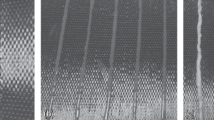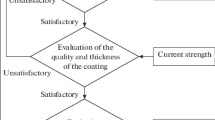Abstract
The thermal decomposition of a carbon fiber reinforced plastic based on a phenolformaldehyde resin and a carbon cloth is investigated. Based on results of thermogravimetric analysis, the pyrolysis process is analyzed and physical and mathematical models for the process are proposed. It is shown that an increase in temperature leads to ablation of both the phenolformaldehyde resin and the carbon cloth. Thermokinetic constants of individual stages are determined. The data obtained are used to predict the ablation of the composite.
Similar content being viewed by others
REFERENCES
E. B. Trostyanskaya (ed.), Heat Resistance of Constructional Plastics [in Russian], Khimiya, Moscow (1980).
Heat-Resistant Plastics, Handbook [in Russian], Mashinostroenie, Moscow (1980).
M. D. Katsnel'son and G. D. Balaev, Polymer Materials [in Russian], Khimiya, Leningrad (1982).
P. J. Schneider, T. A. Dolton, and G. W. Reed, “Mechanical erosion of charring ablators in ground-test and re-entry environments,” AIAA Paper No. 66-424 (1966).
V. V. Nesmelov, “Effect of heating rate on the heat-transfer characteristics in the thermal decomposition of phenolic carbon plastic,” Combust. Expl. Shock Waves, 29, No. 6, 719–723 (1993).
V. I. Zinchenko, G. F. Kostin, and A. S. Yakimov, “Calculation of heat-and mass-transfer characteristics during destruction of thermoprotective material,” Combust. Expl. Shock Waves, 30, No. 4, 477–485 (1994).
V. I. Zinchenko, V. V. Nesmelov, G. F. Kostin, and A. S. Yakimov, “Effect of the mass fraction of a binder in a thermal protective coating on the heat and mass exchange with a high-enthalpy gas flow,” Combust. Expl. Shock Waves, 34, No. 6, 644–650 (1998).
Yu. V. Polezhaev and F. B. Yurevich, Thermal Protection [in Russian], Énergiya, Moscow (1976).
W. Wendlandt, Thermal Methods of Analysis, Wiley, New York (1974).
O. F. Shlenskii, N. V. Afanas'ev, and A. G. Shashkov, Thermal Destruction of Materials. Polymers and Composites under Intense Heating [in Russian], Énergoatomizdat, Moscow (1996).
A. V. Lykov, Theory of Thermal Conduction [in Russian], Vysshaya Shkola, Moscow (1967).
V. V. Korshak, Heat-Resistant Polymers [in Russian], Nauka, Moscow (1969).
G. N. Isakov, V. K. Nesmelov, and G. S. Kas'yanov, “Experimental investigation of combustible forest materials under dynamic heating conditions,” in: Processes of Unsteady Combustion [in Russian], Izd. Cheboks. Univ., Cheboksary (1984), pp. 45–53.
Author information
Authors and Affiliations
Rights and permissions
About this article
Cite this article
Nesmelov, V.V., Gol'din, V.D. & Kostin, G.F. Ablation Characteristics of Thermal Protective Materials Based on Carbon Fiber Reinforced Composites. Combustion, Explosion, and Shock Waves 39, 309–315 (2003). https://doi.org/10.1023/A:1023896320436
Issue Date:
DOI: https://doi.org/10.1023/A:1023896320436




